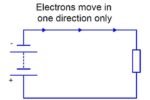Difference between Alternating Current and Direct Current for better understanding.
The difference between Alternating current and Direct current has been discussed in length in this post. The main difference between Alternating Current and Direct Current is the direction of the flow of electric charge. Direct Current (DC) is an electric current that flows in one direction, whereas alternating Current (AC) periodically reverses direction. In a DC circuit, the voltage remains constant while the current varies, whereas, in an AC circuit, both the voltage and current vary in a sinusoidal pattern.

Difference between Alternating Current and Direct Current.
The difference between Alternating current and Direct current has been discussed in length in this post. Alternating current and Direct current are two different types of electrical current. The main difference between Alternating current and Direct current is the direction of the flow of electric charge.
Direct current (DC) is an electric current that flows in one direction, whereas alternating current (AC) periodically reverses direction. In a DC circuit, the voltage remains constant while the current varies, whereas, in an AC circuit, both the voltage and current vary in a sinusoidal pattern. More differences between alternating current and direct current are as such;
Voltage and frequency:
With respect to Voltage and frequency, there is a difference between alternating current and direct current. The AC voltage is characterized by its frequency and amplitude. The frequency of AC is typically 50 or 60 Hz, and its amplitude changes with time. DC voltage is constant and does not change with time.
Generation:
So far the power generation is concerned, we found a difference between alternating current and direct current. AC current is generated by a device called an alternator, which converts mechanical energy into electrical energy by rotating a magnetic field inside a coil of wire. DC current is generated by a device called a DC power supply, which converts AC power into DC power.
Transmission:
Transmission of current is an important aspect, where a difference between alternating current and direct current is noticed. AC is more suitable for long-distance transmission because it can be easily stepped up or stepped down using transformers, which makes it possible to reduce energy losses during transmission. DC, on the other hand, is less efficient for long-distance transmission and requires higher voltage to minimize energy losses.
Safety:
Safety is a very important part of the electric current where a difference between alternating current and direct current is found.AC can be considered safer than DC because the human body has a higher resistance to AC current, which means that it is less likely to cause harm in the event of electrical shock. However, both types of current can be dangerous if not handled properly.
Energy storage:
A difference between alternating current and direct current is observed in energy storage.DC is easier to store than AC because it does not require transformers or other specialized equipment. DC can be stored in batteries or other energy storage devices, which can be used to power devices that require DC.
Polarity:
DC has a fixed polarity, meaning that the positive and negative terminals of a DC power supply always remain the same. AC, on the other hand, alternates polarity with each cycle of the waveform. With respect to the polarity above difference between alternating current and direct current is a fact.
Power supply:
The power supply is an important parameter of the current, where a difference between alternating current and direct current is seen.AC is supplied by most utility companies, whereas DC is typically supplied by batteries, solar panels, or other alternative energy sources. In some cases, DC power supplies may be used to power specific devices or applications that require a stable DC voltage.
Noise and interference:
In noise and interference, the difference between alternating current and direct current is also noticed. AC is more susceptible to noise and interference than DC because of the changing frequency and amplitude of the waveform. This can make AC signals more difficult to transmit and receive without error.
Efficiency:
With respect to the efficiencies, a difference between alternating current and direct current is also observed. The efficiency of AC and DC systems depends on various factors, including the voltage and current levels, the length of the transmission line, and the type of equipment being used. In general, AC systems are more efficient for long-distance transmission, while DC systems are more efficient for local distribution and storage.
Cost:
The cost can have a difference between alternating current and direct current. The cost of AC and DC systems can vary depending on the specific application and equipment being used. AC systems typically require more specialized equipment, such as transformers and voltage regulators, which can increase the overall cost. DC systems, on the other hand, may require more specialized components, such as inverters and DC-DC converters, to convert the DC power to AC or to regulate voltage levels, respectively, which can also add to the cost.
Magnitude:
In DC, the magnitude of the electric charge remains constant over time. In AC, the magnitude of the electric charge varies periodically with time.
Frequency:
In DC, there is no frequency because the flow of charge is constant. In AC, the frequency is the number of times the direction of the electric charge reverses per second. The standard frequency for household AC in most countries is 50 or 60 Hz.
Energy transmission:
The difference between alternating current and direct current is also noticed in energy transmission.DC is used for low voltage, high current applications such as batteries, while AC is used for high voltage, low current applications such as power transmission over long distances.
Power efficiency:
AC is more efficient for long-distance power transmission due to its ability to be easily stepped up or down in voltage using transformers. DC power transmission requires expensive high-voltage direct current (HVDC) converters.
Safety:
AC is generally considered safer than DC because transformers can easily reduce the voltage to safer levels. DC voltage, on the other hand, can be more dangerous because it is harder to reduce the voltage.
Applications:
AC is commonly used for household electrical systems, while DC is often used in electronic devices such as computers, televisions, and smartphones. However, with the increasing popularity of renewable energy sources such as solar and wind power, DC is becoming more commonly used in household electrical systems as well.
AC is used to power most household appliances and electrical devices, while DC is used in electronic devices, such as computers, televisions, and cell phones. DC is also used in some types of motors, such as those found in electric vehicles
FAQs of Alternating and Direct Current.
Here are some frequently asked questions (FAQs) about AC and DC:
1. What does AC stand for?
AC stands for Alternating Current.
2. What does DC stand for?
DC stands for Direct Current.
3. What is the main difference between AC and DC?
The main difference between AC and DC is the direction of the flow of electric charge. In AC, the flow of electric charge periodically reverses direction, while in DC, it always flows in one direction.
4. Which type of current is more commonly used in households?
AC is more commonly used in households, as it is the type of current supplied by the electrical grid.
5. Why is DC more commonly used in electronic devices?
DC is more commonly used in electronic devices because most electronic devices require a steady, constant flow of electric charge in one direction.
6. What is the frequency of AC in most households?
The standard frequency for household AC in most countries is 50 or 60 Hz.
7. Why is AC more efficient for long-distance power transmission?
AC is more efficient for long-distance power transmission because it can be easily stepped up or down in voltage using transformers, which allows for the transmission of large amounts of power with minimal losses due to resistance.
8. Why is AC considered safer than DC?
AC is considered safer than DC because transformers can easily reduce the voltage to safer levels. DC voltage, on the other hand, can be more dangerous because it is harder to reduce the voltage.
9. Can AC be converted to DC?
Yes, AC can be converted to DC using a device called a rectifier.
10. Can DC be converted to AC?
Yes, DC can be converted to AC using a device called an inverter.
Conclusion:
In summary, AC and DC are two fundamentally different types of electrical current, with differences in direction, voltage, frequency, generation, transmission, and application. While AC is more suitable for long-distance transmission and is used to power most household appliances, DC is used in electronic devices and some types of motors.



1 Comment
[…] heating effect of electric current,{ which may be Direct Current(DC) or Alternating Current(AC)} is used in a variety of applications, such as heating appliances, welding, and industrial processes. […]